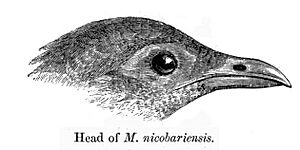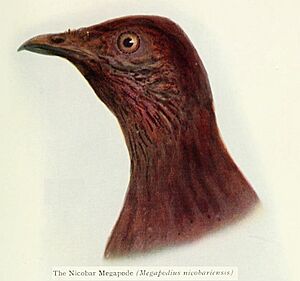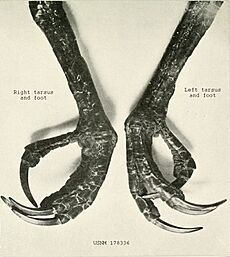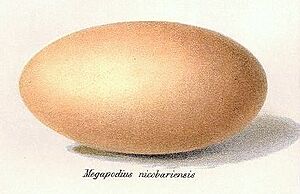Nicobar megapode facts for kids
Quick facts for kids Nicobar megapode |
|
|---|---|
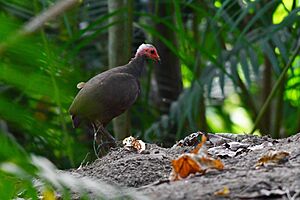 |
|
| Conservation status | |
| Scientific classification | |
| Genus: |
Megapodius
|
| Species: |
nicobariensis
|
| Subspecies | |
|
|
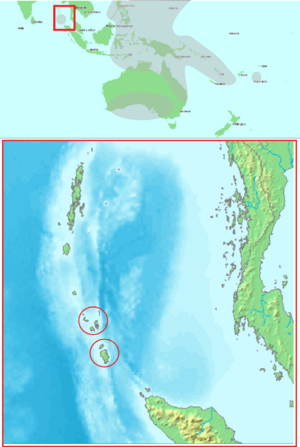 |
|
| Distribution of Nicobar megapode, grey area shows the distribution range of other megapodes | |
The Nicobar megapode or Nicobar scrubfowl (Megapodius nicobariensis) is a special type of bird. It lives only on some of the Nicobar Islands in India. This bird is known for building a very large nest. It uses soil and plants to make a big mound. The eggs hatch inside this mound from the heat made by the plants breaking down.
When the chicks hatch, they are already covered in feathers. They can even fly right away! The Nicobar Islands are far from where other megapode birds live. Because they live on small islands and people sometimes hunt them, these birds are in danger. They are considered vulnerable to extinction. A big tsunami in 2004 sadly wiped out some groups of these birds. It also made their numbers much smaller on other islands.
Contents
What the Nicobar Megapode Looks Like
Megapodes get their name from their large feet. The word "megapode" means "large foot." Like other birds in this group, the Nicobar megapode looks like a chicken. It has dark brown feathers, a short tail, and very big feet with strong claws.
Its lower leg, called the tarsus, has no feathers. The back toe is at the same level as the front toes. This helps the bird grab things better than other game birds. The front of its tarsus has wide, flat scales. Its tail is short and has twelve feathers.
The bird's head is mostly grey. It has a reddish crest on top and bare, reddish skin on its face. Male and female birds look very similar. However, males are dark brown all over. Females have more grey on their belly and chest. Young birds have feathers on their whole face. Baby chicks look like small quails. They have reddish-brown stripes on their wings and back.
Where the Nicobar Megapode Lives
This bird lives only in the Nicobar Islands. This area is very far from where most other megapode birds are found. Some people even thought that these birds might have been brought to the Nicobar Islands a long time ago. This is because many megapodes were kept as pets by islanders.
There are two main types, or subspecies, of the Nicobar megapode. One type lives on the islands north of the Sombrero Channel. The other, darker type lives south of it. These birds have been seen on many islands. Some of these include Tillangchong, Teressa, Camorta, and Great Nicobar.
After the 2004 tsunami, surveys showed that the birds were gone from some islands. These included Trax and Megapode Island. People living on the islands sometimes collect the eggs and hunt the adult birds for food.
Daily Life and Habits
Nicobar megapodes are shy birds. During the day, they hide in the thick jungle near the seashore. When it gets dark, they come out onto the beach. They usually move around in pairs or small groups. These groups can include birds of different ages, even newly hatched chicks.
If they are disturbed, they prefer to run away. But if they are really pushed, they will fly. The birds in a group stay in touch by making cackling calls. Pairs of birds will call back and forth to each other. They also protect their own areas, called territories.
What the Nicobar Megapode Eats
The Nicobar megapode eats many different things. This means it has an omnivorous diet. They find their food by scratching and raking through dirt and leaves on the ground with their feet.
A study on Great Nicobar Island looked at what was in their stomachs. It found that they mostly ate seeds from a plant called Macaranga peltata. They also ate insects, snails, crustaceans (like crabs), and small reptiles. They swallow small stones, called grit, to help them digest their food. They have also been seen drinking rainwater.
Nesting and Reproduction
Like other megapodes, these birds build a very large nest mound. These mounds are usually built close to the coast. They are made from coral sand, tiny shells, and plant materials. This includes leaves, twigs, and other bits of nature.
Mounds are built in open areas. They might be next to a fallen log, a tree stump, or a large living tree. Birds often reuse their mounds. They scrape off the top layer of sand. Then they add fresh plant material. Finally, they rake a new layer of sand over it. One mound might be used by a pair of birds and their young.
New mounds can be built by digging a pit. Or, birds might pile up soil and plants against a stump or log. The size of the mounds can be very different. Some are small, while others are huge. But the size doesn't seem to affect how well the eggs hatch.
The eggs are long and oval-shaped. They are quite large, weighing about one-sixth of the bird's own weight. The birds lay most of their eggs from February to May. The eggs are pinkish and have no marks or shine. They lose their color as they get older.
The parent bird lays an egg on the mound. Then it digs a hole to bury the egg inside. It covers the egg with plant material and soil. On average, 4 to 5 eggs are laid in a mound. But sometimes, up to 10 eggs have been found. These eggs can be at very different stages of development. More than one pair of birds might use a single mound.
Tiny living things, called microbes, create heat inside the mounds. This heat helps the eggs hatch. The eggs take about 70 to 80 days to hatch. This time can change depending on the temperature inside the mound.
When the young birds hatch, they are already covered in feathers. As soon as their feathers dry, they can fly! They don't need their parents to take care of them. They join the group right away.
Other Information
- Sivakumar, K. (2007) The Nicobar megapode Status, ecology and conservation: Aftermath tsunami Wildlife Institute of India, Dehra Dun.



